|
New York Architecture Images-New York Architects Carrère and Hastings |
||||
| New York works; | ||||
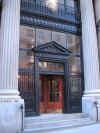
|
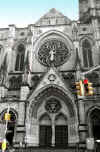 |
 |
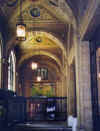
|
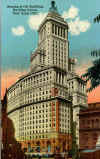
|
| 005
Forbes Magazine Building |
002 Cathedral Church of St. John the Divine | 009-HSBC Bank. | 006 CUNARD BUILDING | 008 STANDARD OIL BUILDING |
 |

|
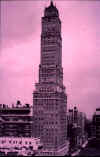 |
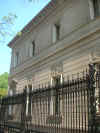 |
|
| 067
New York Public Library |
118
Lunt-Fontaine Theater |
003-Ritz Tower | 044-Frick Collection | 069-Greek Consulate General |
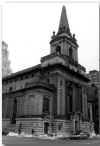 |
||||
| 078-Consulate of the Russian Federation |
CPW @ W96th First Church of Christ, Scientist |
|||
|
The architects were John Merven Carrère and Thomas Hastings of the firm Carrère & Hastings, New York City. Elizabeth Burroughs in her memoirs indicates that her father, Julian Burroughs was the architect for all the bluestone buildings, especially the English Village. This discrepancy may be cleared up if somebody is able to view Thomas Hastings' drawings, some located at the New York Public Library, but more probably at the Avery Architecture Library at Columbia University. A possibility is that Hastings drew up the sketches, and the working drawings and construction was performed by Burroughs. John Merven Carrère (b. 9 November 1858; d. 1 March 1911) was born in Rio di Janeiro, the son of a prosperous American coffee trader whose ancestry reached back to a French family that had come to America during the French Revolution and had settled in Baltimore.. After attending public secondary school in Lausanne, Switzerland and the Institute of Briedenstein, John gained admission to the preeminent design academy of the era, the École des Beaux-Arts in Paris, in 1878. In 1881 Carrère sought out American Thomas Hastings as a partner in a student design project. (later, Hastings noted that John both looked and spoke like a Frenchman, despite his U. S. citizenship) Carrère left the École des Beaux-Arts in 1882. He moved to New York City, and by October 1883, he was a draftsman for the prestigious firm of McKim, Mead and White. Here Carrère continued to learn from Charles Follen McKim (1847 - 1909), who also had studied at the École des Beaux Arts. While at this firm, he again encountered Thomas Hastings. They worked together on a project in Baltimore, liked each other, and decided to break away from McKim, Mead and White in 1885. Carrère married Marion Dell in 1886; they had two daughters. Carrère's personality was not naturally endowed with diplomatic skills. According to family tradition his difficult personality and his entrance into the dubious profession of architecture separated the man from his relatives. One descendant termed him "temperamental and impulsive by nature," and extremely sincere and forthright. "He did not pose." Hastings noted his "seriousness and absolute fearlessness in speaking the truth under all conditions and at all times." Carrère's lack of charm and humor was softened by what Walter Cook called "that buoyant manner, that enthusiasm and that sincere and friendly smile" It is a little surprising that Carrère had such success in dealing with headstrong robber barons, opinionated trustees and officials, inefficient bureaucracies, and laggard contractors. Carrère sought recognition for his efforts, particularly the ribbon of the Legion of Honor, and complained in a letter to Elliott Woods, Architect of the Capitol, bitterly that others, Whitney Warren and S.B.P. Trowbridge in particular, had received that recognition. In the end, Carrère failed in his quest. Some writers indicate that Carrère hoped to be named ambassador to France -- highly unlikely in view of his apolitical activity. In the 1906-1908 period, Carrère designed his own residence in White Plains, NY "Red Oak". As country homes go, this was very modest, especially in comparison to Thomas Hastings' country home in Long Island. The geographical separation indicated that Carrère and Hastings did not socialize frequently outside of their business milieu. Carrère labored tirelessly for the advancement of his profession. He was an active member of the American Institute of Architects, a founding member of the Beaux-Arts Society of Architects. He also worked in less conspicuous ways to help others. According to Hastings, he was "generous to a fault," and always willing to aid students and struggling artists. "if a young man in the office wanted to go to Paris to study, Carrère would arrange to give him extra work to help him save up for it, and after getting him there, he would employ him at generous terms to make a measured drawing of some monument or give him some commission to help support him there" On his death in a taxicab accident in New York City, the trustees of the New York Public Library permitted his body to lie in state in the building so closely associated with his name. Thomas Hastings (b. 11 March 1860; d. 22 October 1929) was born in New York City, the son of Thomas Samuel Hastings, a prominent clergyman, and Fanny de Groot, whose ancestors were of Dutch and Huguenot descent. Thomas was the sixth male descendent to bear this name, the first having arrived at the Massachusetts Bay Colony in 1634.His father was pastor of the West Presbyterian Church and the president of the Union Theological Seminary. His paternal grandfather, also named Thomas Hastings, was a distinguished composer of sacred music, his most famous song being "Rock of Ages." His maternal grandfather, Henry de Groot, was a merchant and writer on law. The family academic background may have helped his academic approach to the discipline and practice of architecture, but Hastings was compelled neither to "accepts the tenets of his father's faith nor join any church." The future architect sprang from a well born, unostentatious, comfortably set New York Protestant family, the type that chose Oceanic, New Jersey rather than Newport, Lenox or Saratoga for a summer vacation. Hastings was endowed with a respectable social position and a familiarity with the city that Carrère lacked. Considered to be a sensitive and nervous child, Thomas was home schooled by his father. Later he attended private school in preparation for college; but at age 17 he abandoned it to enter the offices of Herter Brothers, New York cabinetmakers and decorators, and worked under the chief designer Charles Atwood. At 19, while continuing his job, he began to prepare for the Beaux-Arts by taking instruction for half a day in mathematics, history and French. his successes in the first class concours occurred in January and February 1883. Back in New York he continued to live at the family home on West 46th Street until he married in 1900. Charles McKim, whom he asked to be best man at his wedding, was the architect he admired most. Hastings' choice of McKim rather than of White, with whom he was equally friendly, is significant. In character McKim and Hastings both possessed ironclad integrity, serious purpose, exacting thoroughness, and a measure of personal dullness. Hastings seems to have enjoyed life, his practice, and his fame much more than did McKim. Among his friends and clients, Hastings numbered powerful, self-made bankers, industrialists and railroad moguls who usually avoided the more spectacularly publicized events of the decade. Like these men, he preferred the steady office routine and the respectable domesticity of New Jersey and Long Island residential communities. Helen B. Benedict or Greenwich, Connecticut, a handsome daughter of E. C. Benedict, sprang from this milieu. She was the only woman in his life. They married in 1900 after a friendship of ten years, but never had children. Helen erected a stable home life around him, providing warmth, encouragement and practical necessities. Hastings built "Bagatelle" in Westbury, LI, in 1908. Like Carrère he wanted simplicity; but living on Long Island where the principal interest of the residents was horses, he placed a low stable with four box stalls at one end of the entrance court. After Carrère's death, Hastings joined with a number of collaborators. He died at the Nassau Hospital, Mineola, Long Island following an operation for appendicitis. At articulate writer, Hastings advanced the cause of Beaux-Arts architecture in America.
The firm, Carrere & Hastings.
When Carrère and Hastings found they worked well together on the
Baltimore project, they decided to branch out on their own and left
McKim, Mead and White. Their first major project was the result of
connections: Henry Flagler was a parishioner of the West
Presbyterian Church and a friend of pastor Hastings, but his business
interests had moved on from Standard Oil to railroads, and he believed
that the railroad would open up Florida to development. Hastings' social contacts quickly attracted many clients for private and business projects. Often a single client would commission a town house, a country home, and also a business building -- not always in that sequence. The era 1890-1917 is often termed Edwardian, in deference to the mentality of the men who had made their wealth during and after the Civil War. They looked to the British pattern of respectability, and copied the notion of townhouse and country estate. Since trustees of public agencies and government officials were tightly intertwined with the baronial set, the firm was able to receive several public building commissions -- often via competition. Carrère himself had suggested the ground rules for competition juries, which were accepted almost universally. The two men worked well together. Hastings usually did the design work, with Carrère developing the working drawings, dealing with the patrons and also the contractors. Both Hastings and Carrère exhibited great sensitivity to placement of buildings within a larger landscaping design. In some cases, Carrère alone handled some major park designs, including Hamilton Fish Park on E. Houston Street in New York City. Guiding Beaux-Arts principles. While McKim, Mead and White designed projects from the outside in, Hastings insisted on designing the projects from the inside out. Hastings also felt that the last great advances in architectural design were at the time of the Renaissance, which is why he designed in the Italian, French and Spanish Renaissance styles. Hastings considered later architectural embellishments to be perversions, and generally insisted on returning to the earlier Renaissance models. However, Hastings preached that architects ought to make use of modern engineering achievements, notably in steel, reinforced concrete, but also including electricity and other conveniences, all integrated into a Renaissance design. They often used local materials, such as the on-site quarry in the Esopus property for bluestone, and the use of coquina in St. Augustine. Hastings' designs for country houses incorporated several new features. His main halls were general placed perpendicular to the entrance axis, staircases were banned from prominent positions, and hallways were designed to lead to all the functions of the building. The New York Public Library. This is the firm's most famous project, and was won through a competition, to the surprise of many other architects. Samuel J. Tilden, a governor of New York State, had left $3.5 million in his will for support of libraries. At the time there were two major libraries in New York City, both losing money: the Astor and the Lenox. Someone suggested that the three groups merge their efforts -- a proposal that made sense. The site chosen was then a reservoir for the Croton water supply system, along Fifth Avenue between 40th and 42nd street. John S. Billings was appointed Director of the New York Public Library on January 15, 1896, and this appointment determined to a very large extent the character of the eventual building. One library authority, Charles Soule in 1902 wrote "Plan always from the inside outward. Do not consider any feature of the exterior or of construction until the problems of administration and growth for Libraries generally, and the particular library in hand, have been thoroughly examined and understood." This accorded completely with Hastings approach to projects. Eighty -eight proposals were submitted in the first competition, but the Executive Committee of the library feared that the large number of proposals had led major firms to prescind from entering the competition. So the Committee polled itself as to who were the major firms, and selected the top six, including McKim, Mead and White and Carrère & Hastings. From his vacation spot, McKim cabled the committee protesting the circular's insistence that the Billings plan be followed; his prestige led the committee to soften its insistence. The competition closed November 1, 1897. On the following day, the jury deliberated at the Astor Library. Carrère & Hastings received four votes, it nearest competitor three, and McKim, Mead and White placed third, probably because it had changed the interior arrangements to adjust to their exterior design. On November 10, 1897, the Trustees approved the jury recommendation, and Carrère & Hastings were commissioned the architects. The jury affirmed that "the Carrère and Hastings entry presents a consistent, skillful and artistic solution of practical and structural problem" They considered it "direct and dignified in treatment" and predicted it would give the City of New York a "beautiful, noble and monumental building." The design and construction took twelve years, but the result is magnificent. It exemplifies some of Hastings ideas. The staircases are almost hidden from view, at the extreme left and right of the entrance hall. (Note that busts of Carrère and Hastings are in alcoves on the staircase; Oliver Hazard Payne is listed in the main entry hall as a contributor.) The Lennox library was located at Fifth Avenue and 70th street. Later this became the site of the Frick mansion, designed by Carrère & Hastings (probably after Carrère's death). The library and the Frick mansion construction sandwiched that of the Payne mansion, and the similarities of exterior treatment with limestone and flat surfaces are extraordinary. The most prominent period of the firm was between 1890 and 1917. The list at the end of this section shows some of the 600 known projects. I tried to concentrate on the period just before the Payne commission and shortly thereafter. The country houses were a part of their practice in which Carrère and Hastings attained a dominant position, achieving great success and influence, primarily in their insistence on integrating the house into the natural surroundings and creating a multi-faceted country existence for their wealthy clients. The Payne property in Esopus. Oliver Hazard Payne put together his 486+ acre estate in 1908 and 1909 through the intermediary of William S. Fuller, probably a lawyer in Payne's attorneys' firm, who purchased the properties to cloak the identity of the actual purchaser. Curtis Channing Blake indicates that Carrère & Hastings did prior work for Payne, location unknown, but probably a town house in New York City. There is also work for William H Payne, grain merchant, on 40th Street as early as 1895. This Payne was not a brother, but may have been a relative from either Cleveland or Hamilton, NY. However, there is substantial work for Henry Flagler who was a close partner of Payne from 1872 through 1884, and who continued to involve Payne in investments after the latter year. In 1899 there is work in Aiken, South Carolina for William Clifford Whitney, Payne's brother-in-law. Oliver built and donated a New York city house for William Whitney and Flora Payne, and occupied quarters on the second floor for many years. Since Oliver contributed heavily to Grover Cleveland's campaign for the presidency, it would not be beyond belief that Oliver contributed or commissioned Cleveland's headstone in 1909. However, Cleveland's best friend was E. C. Benedict, Hastings' father-in-law, and William C Whitney was a close associate of Cleveland. Apart from family or business connections, Payne would move in the circle of industrialists who favored Carrère & Hastings. Note also that the firm had done substantial work in design of country homes in the first decade of the 20th century. The Esopus mansion exhibits many of Hastings' favorite concepts. The main entrance is from the east, and leads into a hall perpendicular to the entrance axis. The stairway, though elegant, is hidden from first view, and does not contribute to the visitor's initial impression. The major portion of the mansion is U-shaped, with the hallways facing the patio and leading to all the important rooms on the first floor. One variation in the Hastings design was closing off the U-shape to make the building rectangular, with servant quarters and utility rooms in the fourth wing. Hastings incorporated new technology into the building. It was wired for electricity, and there was a central vacuum system servicing all the main rooms on the first and second floors. Naturally he used steel and reinforced concrete. The exterior surface was imported limestone, while the gatehouse and greenhouse buildings are of Indiana limestone. For the New York Public Library the firm considered limestone from Dover, New York and Vermont, opting for Vermont when Dover was unable to produce enough similar quality limestone. The use of imported limestone may have been ordered by Colonel Payne himself. Legend has it that Payne noticed a building on the Italian coast during one of his summer trips to the Mediterranean, and told the architects he wanted a similar building. When they pointed out that the lifetime of the imported limestone might not be longer than 20 years, he answered that he himself wouldn't last 20 years, so import the limestone! Another of Hastings' contributions to architecture was to separate the exterior surface of a building from the basic construction. It was Hastings who coined the term "curtain wall"; the building would stand on its own, with the curtain wall, be it brick or limestone, not part of the structural entity. In their design of country houses, Carrère and Hastings took great pains to make the buildings blend in with the landscaping. In the Esopus project, they added the wall on the eastern view to mute the stark elevation of the building and fold it more gently into the hill. Hastings disliked the trend toward skyscrapers, and argued that buildings constructed for business profits ought to be restricted in height, so as to maintain a certain look to the entire city. His arguments were modified to demand setbacks of tall buildings, but he thought this a perversion. In this, he was a throwback to Beaux-Arts thought. Even today, Paris has only a single skyscraper (Eiffel Tower excepted), built shortly after World War II, and the city fathers immediately realized it was a mistake. Now all tall buildings are exiled to la Défense, across the Seine. This certainly gives a beautiful look and feel to Paris, even if the casual observer doesn't identify why. l'Envoi Carrère & Hastings were a firm entirely consistent with the Edwardian era or the Gilded Age, which came to an end by 1929. The next generation of the rich did not feel the need to imitate the British model, and began to choose younger architects with fresher vision than either McKim, Mead and White or Carrère and Hastings.. When the personal income tax legislation was enacted, it became difficult to justify country estates which required six persons minimum inside and six persons minimum outside. (In its heyday, Payne's estate employed over 60 people.). The final blow was the depression of 1929, when the number of fortunes shrank precipitously because so much of the wealth was in the form of stock. Newer concepts came into vogue. The Beaux-Arts period faded quickly, and had its critics especially after 1900. One, J. Steward Barney, a proponent of Gothic style architecture expressed annoyance at the development of highly rewarded drafting skills at the expense of real architecture. In 1909 he wrote " When I get the money, I intend to have a silk rug made, on which I intend to use the beautiful pattern manufactured by Messers. Carrère and Hastings, and entered by them as the plan for the Cathedral of St. John the Divine. I am going to give that rug to Tom as a prayer rug, upon which to pray for forgiveness for the things he has done" "it is clear that the leaders of modern architecture, Sullivan, Wright, Le Corbusier, Mies, and Gropius did not define their architectural vision with such narrow social and economic limits as Carrère and Hastings. ... The more progressive individuals of this century had eyes that moved over the whole human landscape, minds that embraced large social problems, and consciences that were founded upon more democratic ideals. Their sensibilities were attuned not to a nostalgic re-evocation of historic images and periods, but to the realities of the years in which they lived. For their patronage they relied not upon a delicate financial and social structure that collapsed resoundingly in 1929, but upon the rising level of social consciousness that preceded and then accelerated that important date. In the most general terms, the moderns negotiated, and in some cases stimulated the large shift in architectural activity from the private to the public domain. They anticipated and made history. What can be said about Carrère and Hastings and their output is that they stayed exactly even with and brilliantly reflected their times. They seem as remote to us as the builders of the Pantheon; but by the same token, as enjoyable in their great works." Curtis Channing Blake, The Architecture of Carrère and Hastings, 1976, pp. 374-275. Many Carrère & Hastings plans were destroyed when the firm split into two units around 1920, so to this date no plans for the mansion, gatehouse or greenhouse area have been found. Some plans were donated from one section of the split to the Avery Library of Architecture at Columbia University. We also searched the documents and plans given to the library by the Guastavino Fireproof Construction Company, which probably was a subcontractor on the Esopus project for the main staircase and the vaulting over the larger rooms. |
||||
|
links |
||||